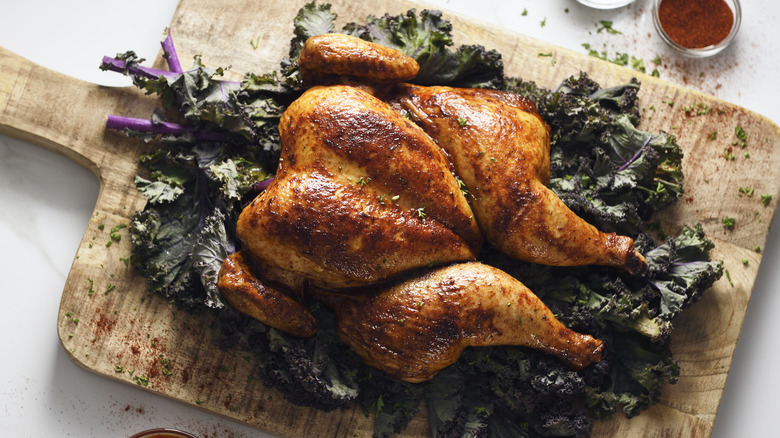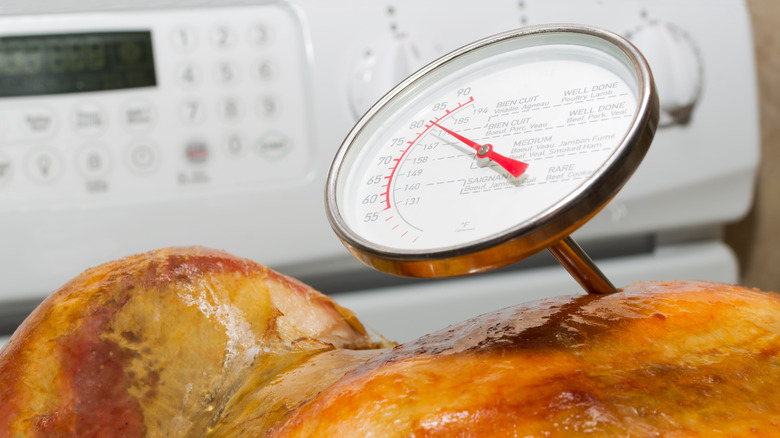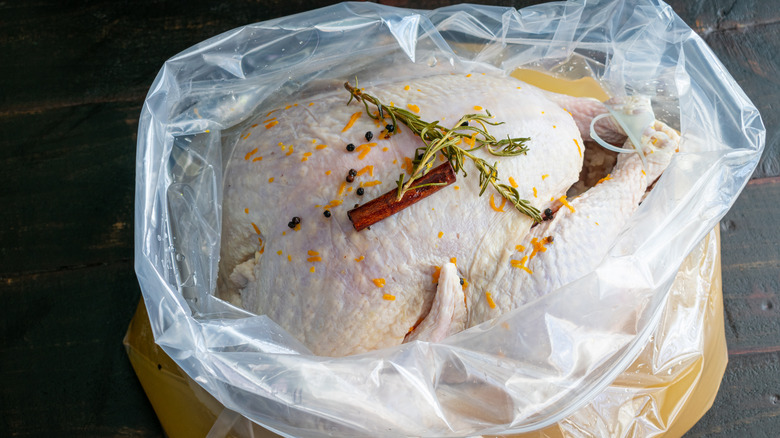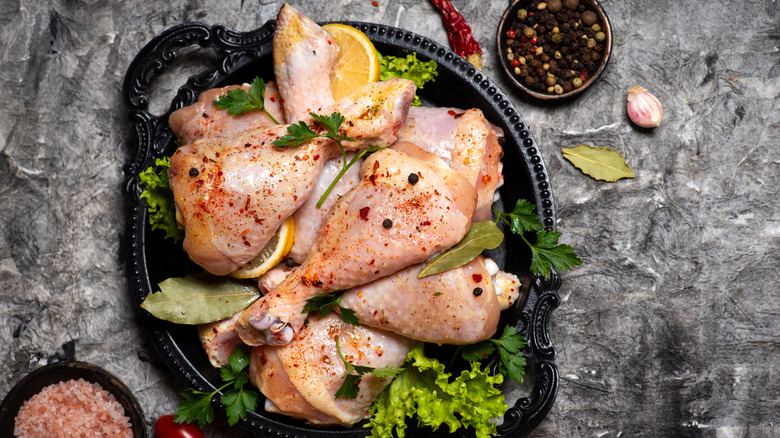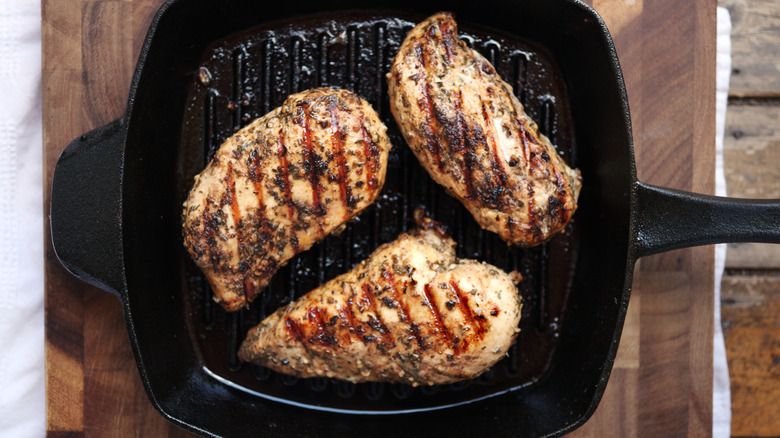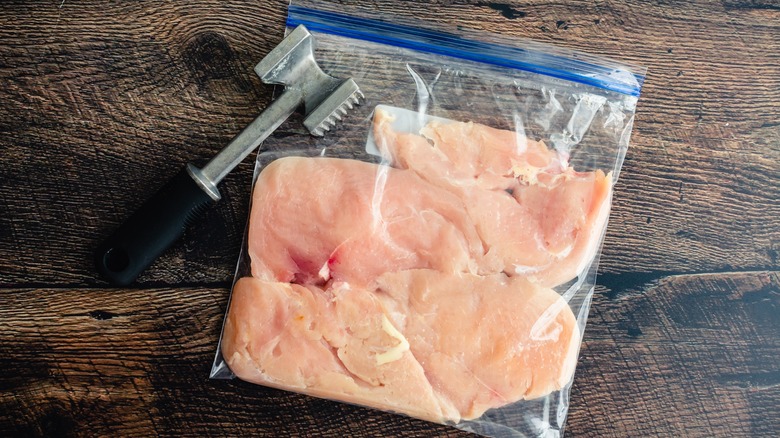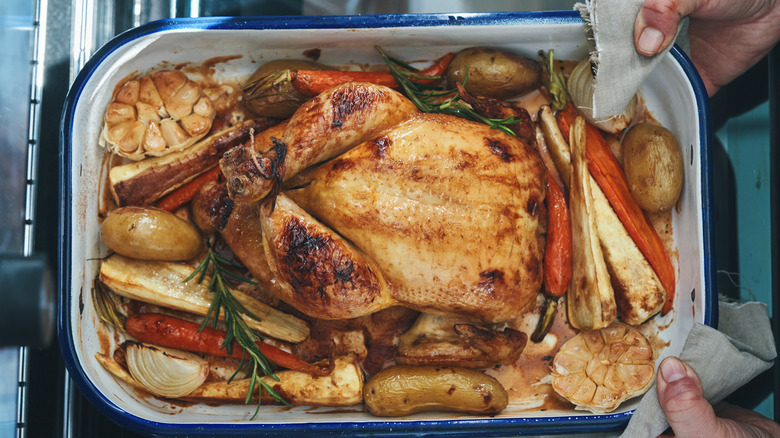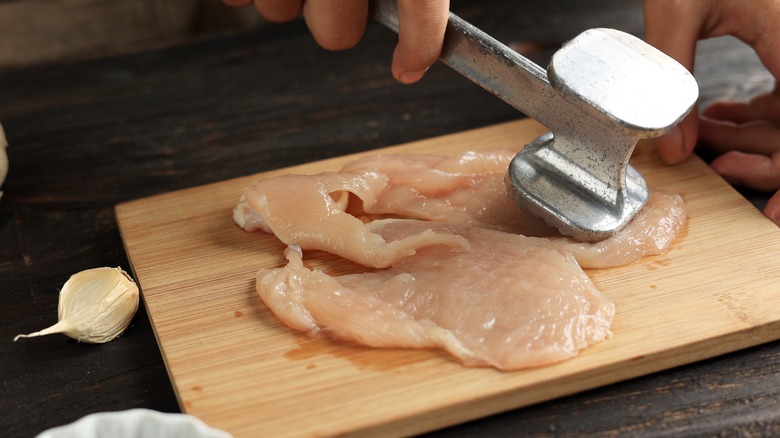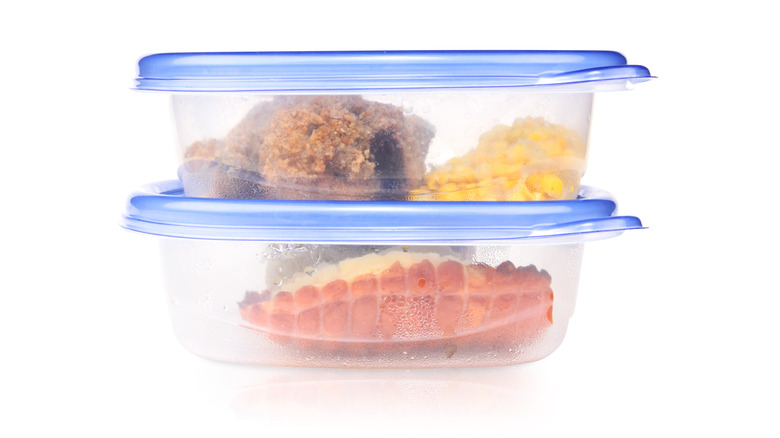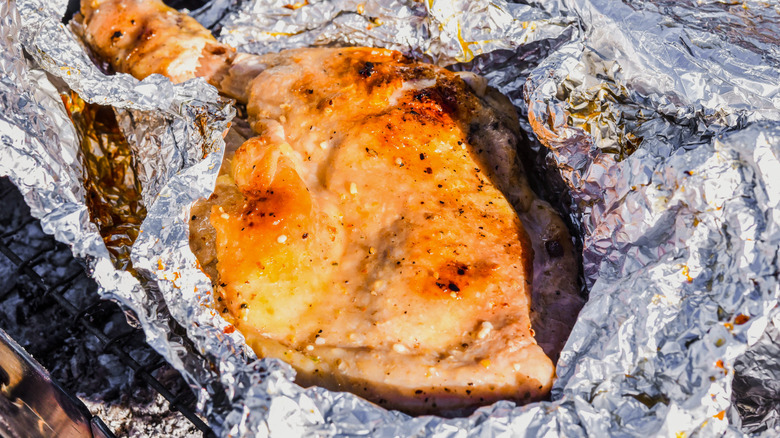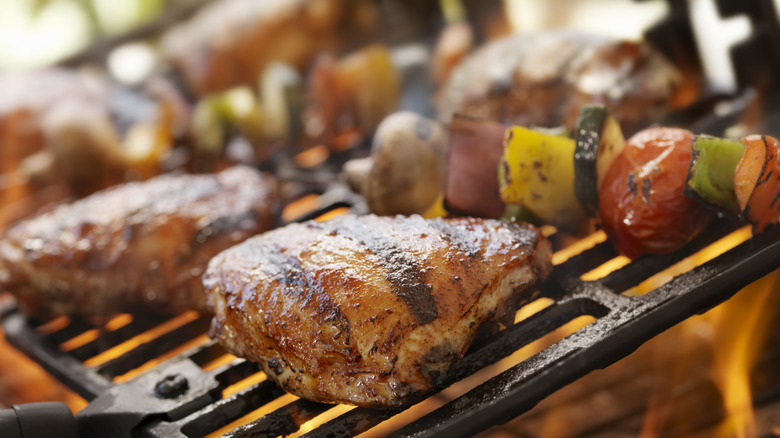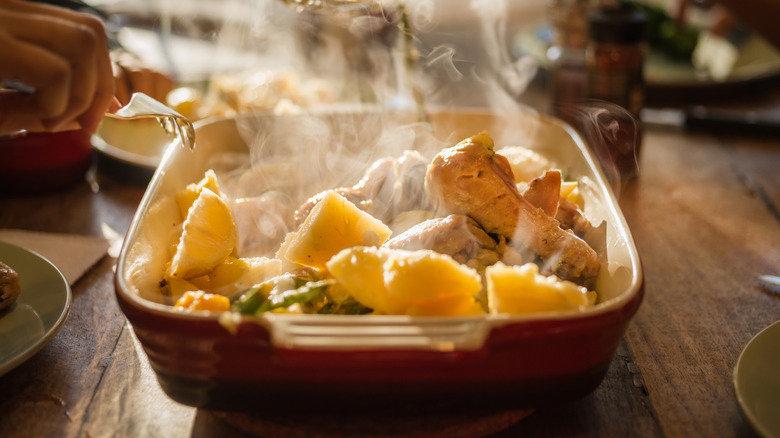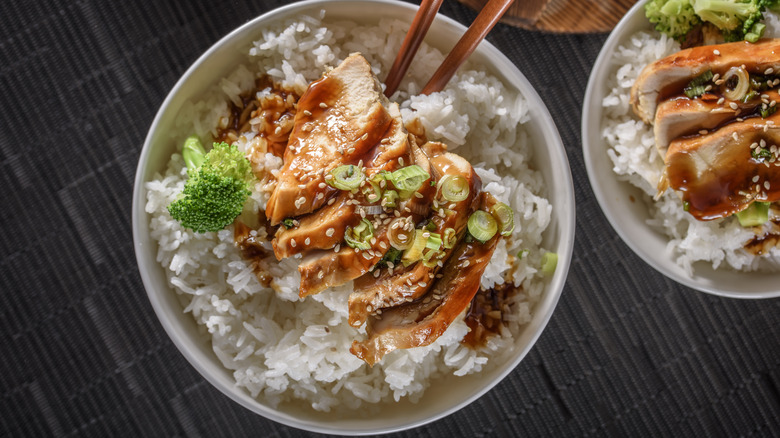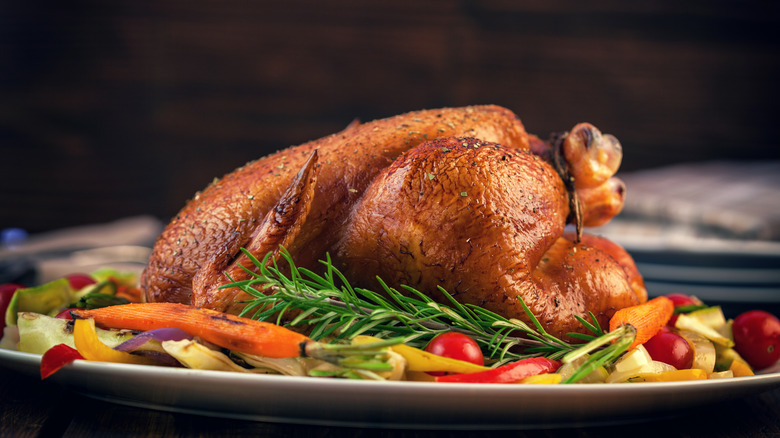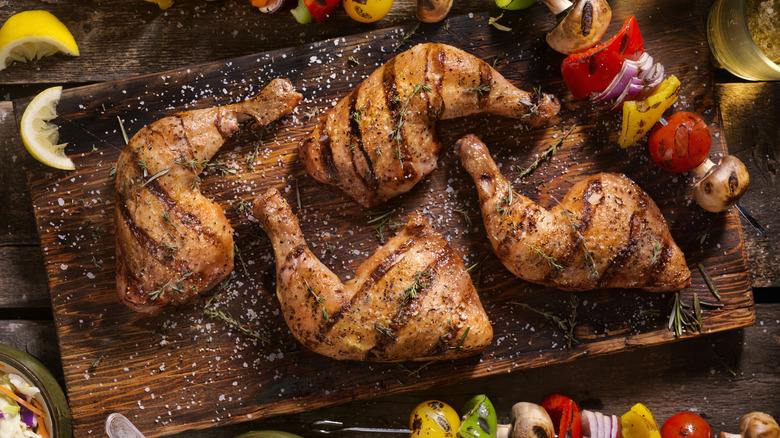14 Ways To Prevent Dry, Overcooked Chicken
It's no wonder why when it comes to cooking meat, chicken wins the popularity contest, being the most widely consumed meat in the United States. In fact, according to historians, humans have been eating chickens for thousands of years. Chicken is lean, tasty, and relatively inexpensive compared to other meats, and it can be incorporated into a wide variety of different cuisines. It has a mild taste, which makes it easy to pair with other foods and flavors to make a perfect plate for lunch or dinner.
But cooking chicken is not as easy as it may seem. The most common issue with poultry is that it tends to dry out during the cooking process, leaving you with a chewy, tough mouthful of chicken, a reality that is hard to swallow. Fortunately, there are ways to avoid this sad state of affairs.
If you follow some simple tips and tricks, you can avoid ever having to dine on dry chicken again. You'll be making meals in no time that feature this versatile, healthy bird at its juiciest and most delicious.
1. Use a meat thermometer
Making moist, succulent chicken is all about precision. The most common mistake that leads to dry chicken is overcooking it. Chicken can't be cooked rare or medium like red meat because it can contain salmonella, a bacteria that can lead to severe stomach issues, so people often cook it too long to be sure that the bacteria are rendered ineffective. But if you get a meat thermometer, you can cook your chicken enough to kill the bacteria without sacrificing that perfect flavor and texture.
To maximize both safety and delicious flavor, the ideal temperature for perfectly cooked chicken is 165 degrees Fahrenheit (73.9 degrees Celsius), a temperature that applies to both white and dark meat. If the internal temperature of your chicken reaches much higher than this, it's likely to become tough, dry, and hard to chew; if you use a meat thermometer, you can stick to the magic number and enjoy juicy chicken every time.
2. Brine your chicken
Chicken is a double-edged sword. It's low in fat and rich in protein, which is why it is such a great option when it comes to healthy meals, but this is also why chicken tends to dry out when you cook it. Though it might seem counterintuitive, the secret to moist chicken is salt — more specifically, a salt brine.
Brining is the process of infusing a protein with salt. When the salt enters the meat in question, it chemically changes the shape of the protein to allow more water to enter the meat, so that you end up with a juicier, more tender result. There are two ways to brine chicken: wet brining and dry brining. The former entails soaking chicken in a mixture of water, salt, and (if you choose) sugar, herbs, and spices, while dry brining means rubbing a salt mixture on the outside of the poultry. In both cases, you'll need to leave the chicken in the brine for several hours before cooking to allow the mixture to fully infuse into the meat to maximize the impact of the brine.
3. Make a marinade
On its own, chicken has a very mild, slightly savory flavor, which is why it is such a great candidate for taking on other tastes and flavors. One way to add flavor, and to make your chicken taste more moist in the process, is by using a marinade. A typical marinade contains an acid (often lemon juice or vinegar), an oil (often olive oil), and the spices of your choice — a delicious combo that helps keep your chicken coated in flavor. (This tahini-marinated grilled chicken is a great example.)
The amount of time you marinate your chicken depends on the cut that you're working with. If you're using cuts with bones, like wings, drumsticks, or bone-in breasts, you generally want to let your chicken soak for a bit longer, but if you're using smaller pieces, you don't need to leave them in so long to get the full effect of the marinade. That said, even marinating chicken for 30 minutes before cooking can give you a juicier outcome. But on the flip side, if you let your chicken soak for too long, especially in an acidic marinade, it can begin to break down the proteins and make the meat mushy.
4. Know the different cuts
There are two kinds of people in this world: those who like dark meat and those who like white meat. Dark meat chicken, which includes thighs and drumsticks, is so called because it has a slightly deeper color due to its myoglobin content, while white meat, like chicken breast, is lighter in color and contains less fat. Whether you're cooking with chicken thighs, breasts, wings, or drumsticks, it's crucial to know how to cook each cut of meat differently in a way that maximizes a juicy, tender flavor.
If you're working with a recipe that requires the chicken to be exposed to high heat over a long period of time, like a sheet pan chicken recipe that requires baking, it's usually best to go with dark meat because it is naturally more moist and less likely to dry out under those conditions. Boneless, skinless breasts are better for pan frying because you can use a hot pan to give them a nice outer crust and cook the inside just enough to keep it moist and tender.
5. Pound the meat out
Although chicken breast has a reputation for being a simple piece of meat to cook, it's not an easy task to execute if you want moist, juicy chicken. Chicken breasts often have one nice, tender bite in the middle, but the edges are bone dry. But there is a simple trick that makes chicken breasts so much better, and all you need is a little brute force.
If you pound your chicken breast to an even thickness before it hits the grill or the pan, cooking it evenly becomes much easier because you avoid the problem of having dry spots where the meat is thinner and cooks much more quickly. Also, when you have a thinner piece of meat, it's easier to bring it all up to the right temperature at the same time and get the center cooked without drying out the edges. And you don't need any specialty equipment — you can use a whole host of common kitchen items. Wrap your chicken in plastic or parchment paper and you can hit it with a rolling pin, a jar, or a wine bottle until it reaches an even thickness. And get some of that pent-up energy out while you're at it!
6. Cook it low and slow
If you're chicken keeps coming out dry, you might have that heat turned up a little too high. The key to getting that perfectly moist, juicy cut of chicken is patience. When you cook chicken longer at low temperatures versus a quick blast of heat, you're more likely to wind up with a product that retains moisture and delivers a more pleasant dining experience.
When roasting a whole chicken, for instance, there's a tendency to want to turn up the heat to get that skin nice and crispy. The problem with that method is that once the dark meat is done cooking, the white meat has dried out already. The secret is that you should be slow roasting chicken to keep it juicy, with an oven temperature of around 300 degrees, and leave the bird in the over for much longer so that it can cook evenly. For pan-seared chicken breasts, after you give them the initial char with high heat when they hit the pan, turn the flame down to medium low to finish cooking them so that the outside doesn't dry out.
7. Use a meat mallet
When chicken is overcooked, it is not exactly a pleasant experience to chew. The muscle fibers are long and stringy and sometimes it can seem impossible to swallow a bite of chicken without a glass of water to wash it down with. Instead of tiring your jaw out trying to get that lean protein, you can break up the fibers before the cooking process even begins by using a meat mallet so that the chicken melts in your mouth.
The tip to remember when tenderizing a cut of meat with a mallet is that the two different sides (one spiky and one flat) have different applications. The spiky side is usually used for red meat while the flat side is used for chicken. When you're pounding the meat, make sure to do it slowly and lightly so that you avoid turning your piece of chicken into a pile of mush.
8. Store your chicken properly
If you want your leftover chicken to stay tasting fresh and succulent, you've got to do your homework. A good chef is a knowledgeable chef, so it's worth it to do some research before you pack up the leftovers after a day of grilling, baking, or roasting.
The simple storage tip to keep boiled chicken moist, for instance, is by putting it in the refrigerator in the same liquid that you used to boil it so that the moisture doesn't seep out of the meat (just remember to cool the liquid down before you put it in the fridge). For most other types of chicken, it's important to store the meat in an airtight container like a Tupperware or plastic sandwich bag so that the air circulating in the fridge doesn't strip the meat of its moisture. Chicken usually keeps for about four days after it's cooked, so you can keep on enjoying it as a leftover.
9. Cover it with aluminum foil
Aluminum foil is one of the great kitchen inventions of the twentieth century. It is useful for storage, baking, and certainly for helping you cook a moist piece of chicken. You can use foil to cover a piece of chicken on the grill or in the oven to keep the moisture from escaping the piece of meat and leaving it dry and tough, a flavorful method for cooking white meat that won't dry it out. When the steam is trapped inside, your chicken ends up cooking more evenly and will not char or burn as easily because the foil protects the chicken from direct heat.
Because aluminum foil is extremely resistant to heat, you can use it in the oven or on the grill. And not only does covering your chicken in foil keep it nice and moist, but it also prevents juices from splattering all over the inside of your oven and it keeps it from directly touching the grill, so clean-up is a cinch.
10. Leave the skin on
Chicken skin is a divisive topic: Some people love the fatty crunch of it on the outside of a tender slice of chicken, and some people think it's too rich and unhealthy and they remove it before cooking. But the skin isn't just a salty, umami crunch that goes with chicken meat, it actually serves to make your chicken more moist and juicy when you cook chicken with the skin on.
The skin helps trap water during the cooking process and keeps it from evaporating, meaning the moisture is more likely to remain in the chicken meat, which prevents it from becoming dry and chewy. Also, since the meat itself doesn't actually absorb the fat from the chicken skin when it melts, if you're looking for a leaner meal, you can simply remove the skin after the chicken has been cooked, leaving you with a more succulent piece of chicken without the extra calories. So if you're looking for a way to add more flavor to chicken thighs or breasts, you can use the skin and still stay skinny.
11. Give the bird a rest after it's cooked
Patience is a virtue, especially when it comes to chicken. When you're done cooking the perfect bird, you might be ready to dig in right away, but if you want to get the most flavorful, juicy reward from all your work in the kitchen, you've got to let it rest before you start eating. The reason is that the moisture needs time to redistribute within the meat so that the water can be absorbed by the meat fibers.
Although different cuts of chicken demand different resting times, the general rule of thumb is that if you're cooking a whole chicken, let it rest for about 15-20 minutes after you pull it out of the oven and if you're making thighs or breasts, let them rest for abut 5-10 minutes. That said, be careful not to let your bird rest for too long so that you're not eating cold chicken.
12. Serve it with a sauce or gravy
So let's say you've already finished cooking your chicken and it's dry, chewy, and rubbery. Unless you've got a time machine, then you're stuck with it. Even then, there are ways to rescue dry chicken, and one of the easiest ways is by serving it with a sauce or a gravy that coats the chicken meat so that it no longer tastes dry.
Any hearty sauce that you happen to have on hand, especially one that is rich and flavorful, will do the trick, and transform you dry, dull chicken into an entirely new meal. If you have some mayonnaise in the cupboard and a few veggies, you can make a creamy and crispy chicken salad, or you can toss the chicken in some teriyaki sauce to give it that nice, sweet, tangy edge. Either way, if you've got the guts to get creative, your chicken won't stay dry for long.
13. Flip the bird halfway through the cooking process
There is no shortage of tips and tricks when it comes to roasting a chicken in the oven. People have tried everything from rubbing it down with butter to stuffing it with an open can of beer. But there is a tried and true method to ensure that you have a bird that is nice and moist the whole way through: For the juiciest roast chicken, make sure to flip it.
Chickens tend to be roasted with the breast side up and, since the breast is the leanest part of the bird, it is most likely to dry out. If you flip the chicken just after the skin begins to crisp up, then the breast is bathed in the drippings at the bottom of the pan and the juices in the chicken are distributed more evenly throughout the bird, giving you a roast chicken that any chef would be proud to serve.
14. Opt for bone-in chicken
When you're cooking chicken, it's easy to get scared of bones. They often seem inconvenient and difficult to deal with, but opting for bone-in cuts of chicken is a surefire way to have your chicken more moist and succulent every time you cook it. The bone contains fat and flavor that is released into the meat when it is cooked and it helps prevent additional water from evaporating out of the chicken.
Chicken legs and thighs are sold more often with bones, and although they take a bit longer to cook than boneless chicken, they are also more forgiving. If you leave a chicken thigh in the oven a couple of minutes too long, chances are it will be fine, where a boneless chicken breast will turn dry and chew quite quickly if it's overcooked. Bone-in cuts of meat are not only more delicious, tender, and juicy, but they're cheaper than their boneless, skinless counterparts.
